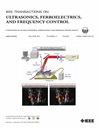Review of the Low-Temperature Acoustic Properties of Water, Aqueous Solutions, Lipids, and Soft Biological Tissues
IF 3
2区 工程技术
Q1 ACOUSTICS
IEEE transactions on ultrasonics, ferroelectrics, and frequency control
Pub Date : 2024-03-26
DOI:10.1109/TUFFC.2024.3381451
引用次数: 0
Abstract
Existing data on the acoustic properties of low-temperature biological materials is limited and widely dispersed across fields. This makes it difficult to employ this information in the development of ultrasound applications in the medical field, such as cryosurgery and rewarming of cryopreserved tissues. In this review, the low-temperature acoustic properties of biological materials, and the measurement methods used to acquire them were collected from a range of scientific fields. The measurements were reviewed from the acoustic setup to thermal methodologies for samples preparation, temperature monitoring, and system insulation. The collected data contain the longitudinal and shear velocity, and attenuation coefficient of biological soft tissues and biologically relevant substances—water, aqueous solutions, and lipids—in the temperature range down to −50 °C and in the frequency range from 108 kHz to 25 MHz. The multiple reflection method (MRM) was found to be the preferred method for low-temperature samples, with a buffer rod inserted between the transducer and sample to avoid direct contact. Longitudinal velocity changes are observed through the phase transition zone, which is sharp in pure water, and occurs more slowly and at lower temperatures with added solutes. Lipids show longer transition zones with smaller sound velocity changes; with the longitudinal velocity changes observed during phase transition in tissues lying between these two extremes. More general conclusions on the shear velocity and attenuation coefficient at low-temperatures are restricted by the limited data. This review enhance knowledge guiding for further development of ultrasound applications in low-temperature biomedical fields, and may help to increase the precision and standardization of low-temperature acoustic property measurements.水、水溶液、脂质和软生物组织的低温声学特性综述。
有关低温生物材料声学特性的现有数据非常有限,而且广泛分散在各个领域。这使得在医学领域开发超声应用(如低温手术和低温保存组织的回温)时很难利用这些信息。本综述从多个科学领域收集了生物材料的低温声学特性以及获取这些特性的测量方法。从声学设置到样品制备、温度监测和系统隔热的热学方法,都对测量进行了回顾。所收集的数据包括生物软组织和生物相关物质(水、水溶液和脂质)的纵向和剪切速度以及衰减系数,温度范围低至 -50°C,频率范围为 108 kHz 至 25 MHz。多重反射法(MRM)是检测低温样品的首选方法,在传感器和样品之间插入缓冲杆以避免直接接触。通过相变区可观察到纵向速度变化,纯水中的相变区很明显,而添加溶质后相变区的速度更慢,温度更低。脂质的相变区较长,声速变化较小;在组织相变过程中观察到的纵向速度变化介于这两个极端之间。由于数据有限,无法对低温下的剪切速度和衰减系数得出更普遍的结论。这篇综述为进一步开发低温生物医学领域的超声应用提供了知识指导,并可能有助于提高低温声学特性测量的精度和标准化。
本文章由计算机程序翻译,如有差异,请以英文原文为准。
求助全文
约1分钟内获得全文
求助全文
来源期刊
CiteScore
7.70
自引率
16.70%
发文量
583
审稿时长
4.5 months
期刊介绍:
IEEE Transactions on Ultrasonics, Ferroelectrics and Frequency Control includes the theory, technology, materials, and applications relating to: (1) the generation, transmission, and detection of ultrasonic waves and related phenomena; (2) medical ultrasound, including hyperthermia, bioeffects, tissue characterization and imaging; (3) ferroelectric, piezoelectric, and piezomagnetic materials, including crystals, polycrystalline solids, films, polymers, and composites; (4) frequency control, timing and time distribution, including crystal oscillators and other means of classical frequency control, and atomic, molecular and laser frequency control standards. Areas of interest range from fundamental studies to the design and/or applications of devices and systems.

 求助内容:
求助内容: 应助结果提醒方式:
应助结果提醒方式:


